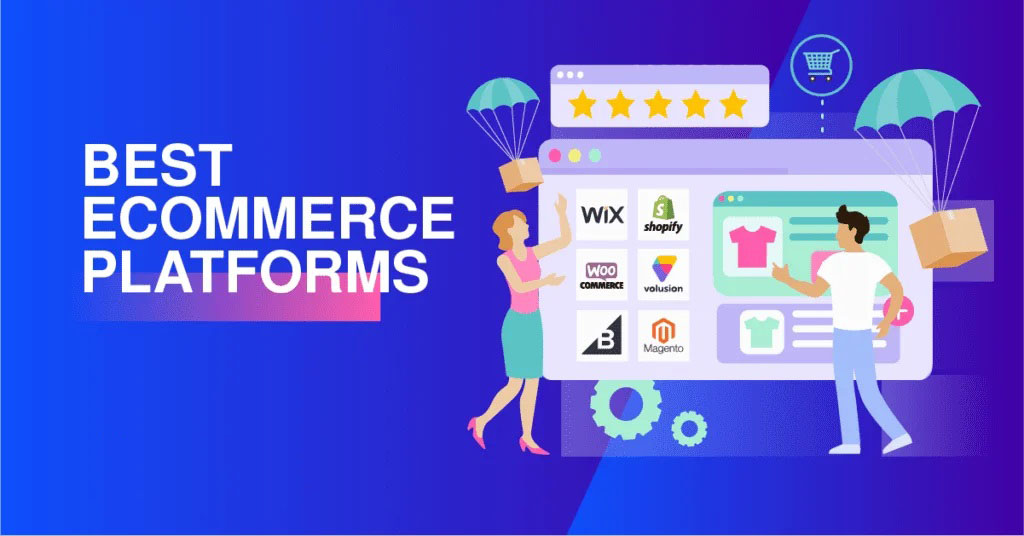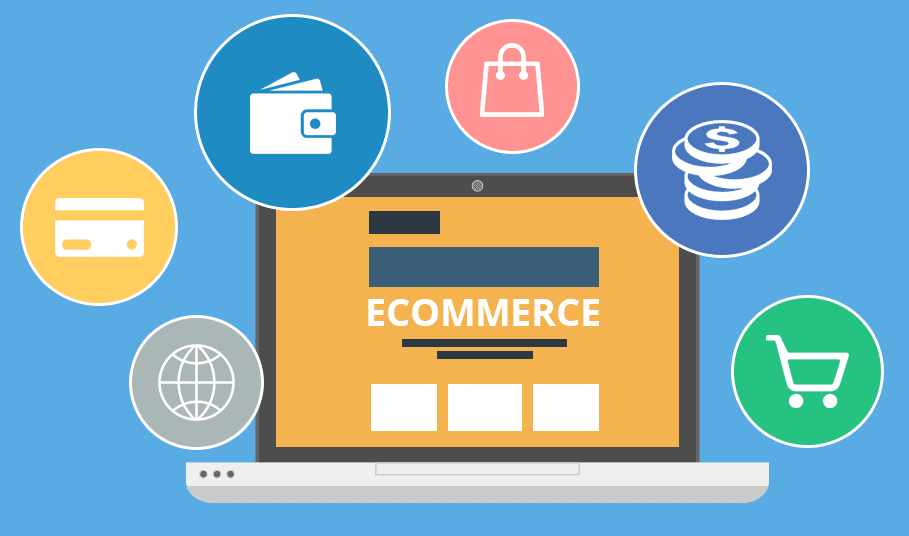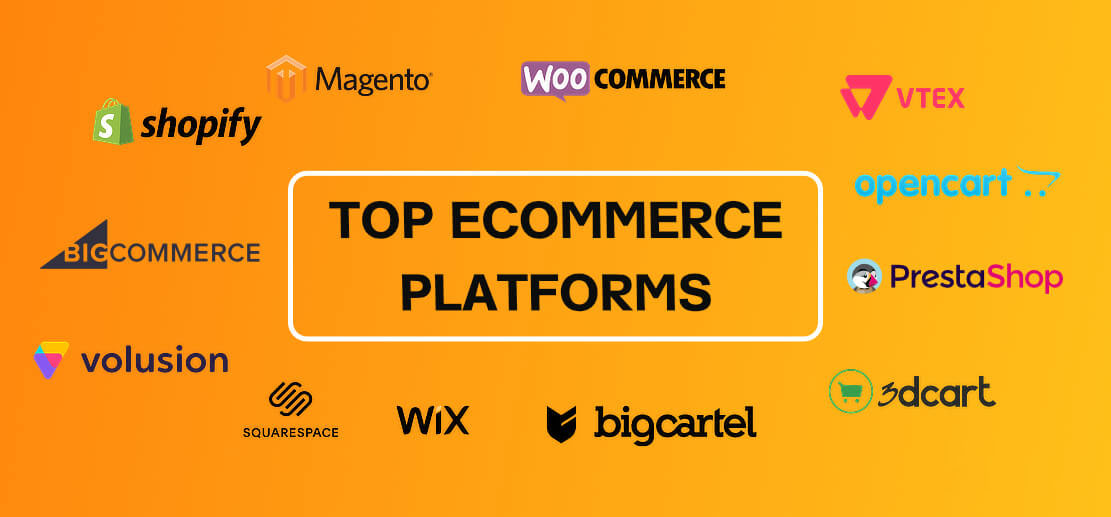Leading e-commerce platforms are in a fierce battle for your attention. But which one truly fits your online business like a glove? You’re about to find out. As you dive in, you’ll get the lowdown on top platforms and how they stack up against each other. From smart features to overall performance, you’ll get the scoop on what makes each platform shine—or fall behind. Whether you’re a small business looking to grow or you’re aiming to dominate the market, this comparison is your roadmap to making an informed choice. Ready to see which platform reigns supreme? Let’s get right to it.
Evaluating Top E-commerce Solutions: Features vs. Performance
Shopify’s Dominance in Usability and Customer Experience
When picking a platform for online sales, think simple. Shopify stands out. It’s got what you need to start selling fast. It’s like a friendly shopkeeper in the world of e-commerce. You get a sharp store without fuss. Thousands agree, making Shopify a favorite. It wins with easy tools and clear layouts. Customers find what they want without getting lost.
Shopify is a top pick for small shops to big brands. It lets you sell across the web. Your stuff can show up on social media and marketplaces like Amazon with just a few clicks. It’s not just about looks; Shopify’s speed is key. Fast pages mean happy customers. Happy customers often come back.
But it’s more than just speed. Shopify offers help when you’re stuck. It has 24/7 support that’s just a call or chat away. And when your store gets big, Shopify grows with you. It can handle lots of visitors at once. That’s why it’s a go-to for many, from newbies to big firms.
Magento vs WooCommerce: A Feature-Rich Comparison
Magento and WooCommerce are like the brains of the e-commerce world. They’re power players. But they’re different. Let’s dive in.
Magento is a beast, in the best way. It’s made for shops that are going places. You can change it to fit your dreams. It’s sturdy and can take on heaps of goods and many buyers at once. But it can be tough to set up. You may need a tech whiz to make the most of it.
Then there’s WooCommerce. It’s the friendly neighbor to WordPress users. It turns your blog into a shop. It’s free and open for you to shape how you like. Add-ons make it even better. You can track sales, sort products, and more. But it can get costly as your shop grows.
So, which is top for you? Think big picture. Magento is great for large shops, and WooCommerce fits bloggers turning sellers. Each brings something special to the table. You have to weigh features against what you need.
In summary, the e-commerce world has stars that shine bright. Shopify is the friend with a hand to lend. Magento is for dreams that aim high. WooCommerce helps bloggers sell with ease. It’s a race where each has its own track. Pick the path that suits your journey.
Remember, more features can mean more complex. The best platform meets your needs today and grows with you for all your tomorrows. It’s not just about what they offer. It’s about what you want to build. And that, my friends, is the key to e-commerce bliss.
The Giants of Online Shopping Platforms: Market Share and User Base
Amazon’s E-Commerce Supremacy and Its Impact on Retail
Amazon is big, like really big. It’s the top spot for online shopping. Why? It’s easy to use, has lots of choice, and people trust it. They sell more than books these days. They sell everything! This giant grabs most of the market share, meaning most money spent online goes to them. Small shops and big stores all feel the heat from Amazon. It makes them up their game. They have to offer better deals, faster shipping, and top service to keep up.
Amazon’s power also pushes other e-commerce sites to do more. They try to match Amazon by making shopping easy and quick.
Analyzing the Success of Big Players in Online Retail
Now let’s look at other major online shopping places. You probably know some of the names like Shopify, Magento, and WooCommerce. They help lots of shops sell online.
Shopify is a star for many shops, big and small. It makes setting up a shop online smooth. You don’t need to be a tech wizard. Plus, your shop can look nice and work well. Shopify shops are popping up everywhere, which means more competition for Amazon.
Magento is another big name. It has a lot of features for online shops. It’s great but can be a bit tricky for newcomers. It’s great for shops that have grown a bit and need more tools.
WooCommerce is a champ because it’s free and simple to tack onto WordPress. It’s perfect for small shops that are just starting or on a tight budget.
These platforms fight to offer the best tools for online shops. They want to make it simple to sell stuff online and manage your shop.
Some things they fight over include:
- How easy it is to set up a shop.
- How well they can handle more shoppers or products as a shop grows.
- How shops can sell in different ways, like through social media.
- The cost to run your shop.
These top e-commerce solutions are changing the game. They have to if they want to keep up with Amazon and each other. Every year, they add new tools or make old ones better. They know online shops have many choices. So, they work hard to be the best pick.
In the end, the big players in online retail offer paths to success. They give you means to open shop, grow, and face the giants. It’s up to you to pick the right path. Remember, what works for one shop might not work for another. Think about what you need. Then choose the platform that fits best for your shop.
Scalability and Integration: Building for Growth
The Importance of Scalable E-commerce Systems for SMBs
Small and medium businesses (SMBs) need room to grow. The best e-commerce systems grow with your business. They handle more sales, products, and even go global without a hitch. Think of platforms as tools. Tools should never hold you back. They should help you fly! Your platform should upgrade as easily as a superhero suit, giving you more powers as you get bigger.
Shopify is the talk of the town for SMBs. Why? It scales with ease. It starts simple. Then, it expands as your online store does. Let’s not forget WooCommerce. It turns any WordPress site into a store. It’s free and flexible, thanks to countless plugins. Magento is also a heavy hitter. It’s like a Swiss army knife for web shops with endless features.
The Role of Integrated E-commerce Solutions in Omnichannel Success
In the e-commerce race, integrated solutions are your best gear. Omnichannel equals more than one way to sell and connect. Websites, mobile apps, social media – they all should work as one. This means everything talks to everything. No more lost data or upset customers. Integration keeps the wheels moving smoothly.
When you hear ‘big players in online retail’, think Amazon. It’s king for a reason. It connects the dots like a master artist. That’s what SMBs need to aim for. A seamless shopping trip, from clicking ‘add to cart’ to the joy of unboxing. All parts of your business should sing the same tune.
Amazon’s might lies in its unified approach. Your shop needs to match that harmony. Shopify, Magento, WooCommerce – each has its own way of syncing everything. This is the secret sauce to happy customers and a booming business.
As an e-commerce expert, I’ve seen what works. It’s clear as day. Shops that grow and impress have two things in common: They scale without stumbling and integrate without hiccups. Whether it’s managing stock or chatting with shoppers, everything should be smooth. That’s how you win in the e-commerce game.
Always check e-commerce software comparison charts. Look for scalability and integration. Remember, it’s not just about a pretty website. It’s about a machine that runs smoothly behind the scenes. And don’t worry, you’ve got this. Your business isn’t a static painting; it’s a dynamic journey. Choose an e-commerce platform that’s your faithful sidekick, ready for the adventure ahead.
Global E-commerce Trends: Understanding Platform Reach and Customer Demands
Leveraging Global E-commerce Platform Reach to Penetrate New Markets
Are you climbing the e-commerce mountain? Great news! Today’s top e-commerce solutions make it easier. They offer a road map to new lands—a must for any growing business. Picture global e-commerce as a giant web. It’s a map that connects you to every corner of the world. Imagine the power!
Online shopping platforms take your products global. With them, you can sell to anyone, anywhere. Platforms with good reach can turn a small shop into a global hit. They open doors to millions of new customers. This power is real folks, and it’s changing the game.
Now, major e-commerce websites are not just sitting giants. They evolve, adapt, and grow. They keep up with what customers want. They offer what you need to spread your wings and soar. Using these platforms, businesses like yours can sell across seas without a hitch.
E-commerce Market Trends and Consumer Expectations
So, what’s driving customers today? Fast, fun, and easy—three words they love. Users want top-notch service at lightning speed. This is where the e-commerce industry leaders come in. They know what folks want. They get the job done right. Amazon e-commerce dominance? Yeah, it’s a thing for a reason. They dish out what shoppers crave.
What’s trending now in online shopping? Smart tech and smooth sites. Your shop needs to be easy to use. If it’s not, buyers might just walk away. Popular e-commerce services know this. They focus on making shopping a breeze. Think fewer clicks and quick views. That’s the way to win hearts.
Shopify performance scores big in this area. Why? It’s all in their design. They make things simple for both shop owners and shoppers. This combo is a knockout. Then, there’s Magento features to think about. They offer a custom-fit suit for your biz. WooCommerce benefits follow close, giving you tools to build as you grow.
All these big players in online retail aim to please. They have an eye on the future. They adapt, offering new tools and tricks to help you keep up. For your shop to shine, you need a platform that grows with you. Scalable e-commerce systems do just that. They stretch and expand, just like your business plans.
Leading e-commerce platforms serve up options to dress up your store: themes, add-ons, special features. E-commerce customization options are the cherry on top. They let you create a shop that feels just right. Remember, in this bustling market, user-friendly e-commerce software wins. And wins big.
When you choose a platform, think about your business. Are you a sprouting startup or a towering enterprise? There’s something for everyone. E-commerce platforms for SMBs fan the flames of small biz dreams. Enterprise-level e-commerce tools lift big businesses even higher.
In a nutshell, it’s about matching your needs with the right tools. From Shopify to WooCommerce, the road to e-com success is paved with smart choices. Keep an eye on e-commerce market trends and consumer expectations. That way, your shop stays fresh, fun, and full of life. Ready to join the online shopping revolution? Let’s go!
We just dove deep into the online store game. We peeped Shopify’s cool tools and smooth shopping vibes. Then, we checked out Magento and WooCommerce, seeing who’s got the best features. We found out Amazon leads big in the web store world. Other online giants are right up there too. Plus, we learned big stuff about growing your store with smart systems that can handle more business. We also saw how having all parts of your store talk to each other helps you sell everywhere. Lastly, we looked at global trends. Smart store owners use these to reach folks in new places and meet what customers now want.
All in all, picking the right e-commerce site is all about what you need and where you’re headed. Keep in mind how many people use the platform, how it helps your store get bigger, and what customers everywhere are into these days. Go for a platform that grows with you and hits the mark on customer wants. That’s the ticket to winning in the online shop world.
Q&A :
What are the top e-commerce platforms available today?
E-commerce businesses have numerous choices when it comes to selecting a platform that can cater to their needs. Some of the leading names in the industry include Shopify, Magento, BigCommerce, WooCommerce, and Salesforce Commerce Cloud. These platforms offer a variety of features tailored to businesses of different sizes, from small startups to large enterprises.
How do I choose the best e-commerce platform for my business?
Selecting the best e-commerce platform involves evaluating your business needs, budget, technical skills, and long-term goals. Important considerations include ease of use, customization options, security features, integration capabilities, and payment processing. It can also be helpful to look at the platform’s scalability and whether it allows for growth without the need to migrate to a different system.
What are the benefits of using a leading e-commerce platform?
Using a leading e-commerce platform can provide your business with a robust infrastructure that ensures a smooth, secure, and efficient online shopping experience for customers. Key benefits include professional-looking templates, SEO optimization features, a wide range of plugins and integrations, reliable customer support, and advanced analytics to track performance.
Are there any free leading e-commerce platforms?
There are several e-commerce platforms that offer free versions or open-source software, such as WooCommerce or Magento Open Source. However, while the core software may be free, additional costs such as web hosting, domain registration, themes, plugins, and development can incur charges. Always consider the total cost of ownership when examining free platform options.
How do leading e-commerce platforms handle mobile shopping?
Mobile shopping is a critical aspect of e-commerce, and leading platforms are designed to be mobile-friendly or mobile-first. These platforms typically offer responsive designs that adjust seamlessly to different screen sizes, ensuring an optimal shopping experience on smartphones and tablets. Some also offer native apps or integrations with third-party mobile app builders to enhance the customer experience on mobile devices.






